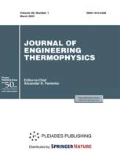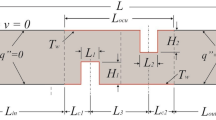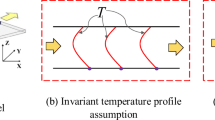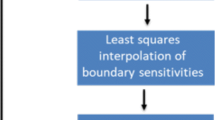Abstract
This work presents a numerical study of incompressible, laminar, two-dimensional, mixed convection flows in horizontal channels with two rectangular alternated blocks mounted in the surfaces. The influence of the geometry and positioning of the blocks on the heat transfer rate is evaluated using Constructal Design. The problem is subjected to two geometric constraints associated with the areas of the channel and the two blocks and three degrees of freedom: \(H_{1}/L_{1}\) (the ratio of the height to the width of the upstream block), \(H_{2}/L_{2}\) (the ratio of the height to the width of the downstream block), and \(L_{3}\) (the horizontal distance between the centers of the blocks). The purpose is to maximize the heat transfer rate per length unit \(q'\) considering three different Reynolds (\(Re_{H}= 10\), 100, and 200) and Grashof numbers (\(Gr_{H} = 650\), 6,500, and 65,000). The conservation equations of mass, momentum, and energy are solved using the Finite Volume Method, and the buoyance forces are modeled with the Boussinesq approximation. In general, the best performance is reached for the largest intrusion of the blocks. However, changes in \(Gr_{H}\) and \(Re_{H}\) affected the optimal distance (\(L_{3})_{o}\), and for \(Gr_{H}=65,000\) non-symmetrical blocks led to the best performance, showing the importance of design investigation for different flow conditions.
















Similar content being viewed by others
REFERENCES
Bejan, A., Convection Heat Transfer, Durham, USA: Wiley, 2004.
Durgam, S., Venkateshan, S.P., and Sundararajan, T., A Novel Concept of Discrete Heat Source Array with Dummy Components Cooled by Forced Convection in a Vertical Channel, Appl. Therm. Eng., 2018, vol. 129, pp. 979–994; https://doi.org/10.1016/j.applthermaleng.2017.10.061.
Min, C., Li, X., Yuan, Y., Chen, Z., and Tian, L., An Inverse Study to Optimize the Rib Pitch in a Two-Dimensional Channel Flow Problem for Heat Transfer Enhancement, Int. J. Heat Mass Transfer, 2017, vol. 112, pp. 1044–1051; https://doi.org/10.1016/j.ijheatmasstransfer.2017.05.001.
Alves, T.A. and Altemani, C.A.C., An Invariant Descriptor for Heaters Temperature Prediction in Conjugate Cooling, Int. J. Therm. Sci., 2012, vol. 58, pp. 92–101; DOI: 10.1016/j.ijthermalsci.2012.03.007.
Karmo, D., Ajib, S., and Khateeb, A.A., New Method for Designing an Effective Finned Heat Exchanger, Appl. Therm. Eng., 2013, vol. 51, pp. 539–550; DOI: 10.1016/j.applthermaleng.2012.09.042.
Sajedi, R., Taghilou, M., and Jafari, M., Experimental and Numerical Study on the Optimal Fin Numbering in an External Extended Finned Tube Heat Exchanger, Appl. Therm. Eng., 2015, vol. 83, pp. 139–146; DOI: 10.1016/j.applthermaleng.2014.12.040.
Kim, J. and Choi, H., An Immersed-Boundary Finite-Volume Method for Simulation of Heat Transfer in Complex Geometries, J. Mech. Sci. Tech., 2004, vol. 18, pp. 1026–1035; DOI: 10.1007/BF02990875.
Molki, M., Faghri, M., and Ozbay, O., A Correlation for Heat Transfer and Wake Effect in the Entrance Region of an In-Line Array of Rectangular Blocks Simulation Electronic Components, J. Heat Transfer, 1995, vol. 117, pp. 40–46; DOI: 10.1115/1.2822320.
Young, T.J. and Vafai, K., Convective Cooling of Heated Obstacle in a Channel, Int. J. Heat Mass Transfer, 1998, vol. 41, pp. 3131–3148; DOI: 10.1016/S0017-9310(97)00323-2.
Desrayaud, G., Fichera, A., and Mea, D., Natural Convective Cooling of a Protruding Heat-Flux Module in a Vertical Channel,Proc. 3rd European Thermal Sci. Conf., Heidelberg, Germany, 2000.
Bazdidi-Tehrami, F. and Naderi-Abadi, M., Numerical Analysis of Laminar Heat Transfer in Entrance Region of a Horizontal Channel with Transverse Fins, Int. Comm. Heat Mass Transfer, 2004, vol. 31, pp. 211–220.
Ismail, M.F., Reza, M.O., Zobaer, M.A., and Ali, M., Numerical Investigation of Turbulent Heat Convection from Solid and Longitudinally Perforated Rectangular Fins, Procedia Engin., 2013, vol. 56, pp. 497–502; DOI: 10.1016/j.proeng.2013.03.152.
Boutina, L. and Bessaih, R., Numerical Simulation of Mixed Convection Air-Cooling of Electronic Components Mounted in an Inclined Channel, Appl. Therm. Engin., 2011, vol. 31, pp. 2052–2062; DOI: 10.1016/j.applthermaleng.2011.03.021.
Pishkar, I. and Ghasemi, B., Cooling Enhancement of Two Fins in a Horizontal Channel by Nanofluid Mixed Convection, Int. J. Therm. Sci., 2012, vol. 59, pp. 141–151; DOI: 10.1016/j.ijthermalsci.2012.04.015.
Bessaih, R. and Kadja, M., Turbulent Natural Convection Cooling of Electronic Components Mounted on a Vertical Channel, Appl. Therm. Eng., 2000, vol. 20, pp. 141–154; https://doi.org/10.1016/S1359-4311(99)00010-1.
Perng, S.-W. and Wu, H.-W., Numerical Investigation of Mixed Convective Heat Transfer for Unsteady Turbulent Flow over Heated Blocks in a Horizontal Channel, Int. J. Therm. Sci., 2008, vol. 47, pp. 620–632; https://doi.org/10.1016/j.ijthermalsci.2007.04.003.
Hernandez, I.V.G., Barbosa, J.G.S., Gutiérrez, C.C.T., Jiménez, J.A.B., and Moreno, L.A.P., Numerical Simulation for Mixed Convective Airflow through a Vertical Finned Channel, Ingenierı́a Invest. Tecnolog., 2014, vol. 16, pp. 157–172.
Durgam, S., Venkateshan, S.P., and Sundararajan, T., Experimental and Numerical Investigations on Optimal Distribution of Heat Source Array under Natural and Forced Convection in a Horizontal Channel, Int. J. Therm. Sci., 2017, vol. 115, pp. 125–138; DOI:10.1016/j.ijthermalsci.2017.01.017.
Bejan, A., Constructal-Theory Network of Conducting Paths for Cooling a Heat Generating Volume, Int. J. Heat Mass Transfer, 1997, vol. 40, pp. 799–816; DOI: 10.1016/0017-9310(96)00175-5.
Bejan, A., Shape and Structure, from Engineering to Nature, Cambridge, UK: Cambridge Univ. Press, 2000.
Bejan, A. and Lorente, S., Design with Constructal Theory, New Jersey: Wiley, 2008.
Bejan, A. and Zane, J.P., Design in Nature, New York: Doubleday, 2012.
Bejan, A., The Physics of Life: The Evolution of Everything, New York: St. Martins, 2016.
Bejan, A. and Almogbel, M., Constructal T-Shape Fins,Int. J. Heat Mass Transfer, 2000, vol. 43, pp. 2101–2115; DOI: 10.1016/S0017-9310(99)00283-5.
Lorenzini, G., Biserni, C., Estrada, E.D., Isoldi, L.A., dos Santos, E.D., and Rocha, L.A.O., Constructal Design of Convective Y-Shaped Cavities by Means of Genetic Algorithm, J. Heat Transfer, 2014, vol. 136, p. 0-10; DOI:10.1115/1.4027195.
Estrada, E.D., Fagundes, T.M., Isoldi, L.A., dos Santos, E.D., Xie, G., and Rocha, L.A.O., Constructal Design Associated to Genetic Algorithm of Asymmetric V-Shaped Pathways, J. Heat Transfer, 2015, vol. 137, p. 061010; https://doi.org/10.1115/1.4029868.
Xie, G., Song, Y., Asadi, M., and Lorenzini, G., Optimization of Pin-Fins for a Heat Exchanger by Entropy Generation Minimization and Constructal Law, J. Heat Transfer, 2015, vol. 137, p. 061901; https://doi.org/10.1115/1.4029851.
Hajmohammadi, M.R., Introducing a \(\psi\)-Shaped Cavity for Cooling a Heat Generating Medium, Int. J. Therm. Sci., 2017, vol. 121, pp. 204–212; https://doi.org/10.1016/j.ijthermalsci.2017.07.010.
Bello-Ochende, T., Meyer, J.P., and Bejan, A., Constructal Ducts with Wrinkled Entrances, Int. J. Heat Mass Transfer, 2009, vol. 52, pp. 3628–3633; https://doi.org/10.1016/j.ijheatmasstransfer.2009.03.014.
Bello-Ochende, T., Olakoyejo, O.T., Meyer, J.P., Bejan, A., and Lorente, S., Constructal Flow Orientation in Conjugate Cooling Channels with Internal Heat Generation, Int. J. Heat Mass Transfer, 2013, vol. 57, pp. 241–249; https://doi.org/10.1016/j.ijheatmasstransfer.2012.10.021.
Rodrigues, M.K., da Brum, R.S., Vaz, J., Rocha, L.A.O., dos Santos, E.D., and Isoldi, L.A., Numerical Investigation About the Improvement of the Thermal Potential of an Earth-Air Heat Exchanger (EAHE) Employing the Constructal Design Method, Renewable Energy, 2015, vol. 80, pp. 538–551; https://doi.org/10.1016/j.renene.2015.02.041.
Vieira, R.S., Petry, A.P., Rocha, L.A.O., Isoldi, L.A., and dos Santos, E.D., Numerical Evaluation of a Solar Chimney Geometry for Different Ground Temperatures by Means of Constructal Design,Renewable Energy, 2017, vol. 109, pp. 222–234; https://doi.org/10.1016/j.renene.2017.03.007.
Martins, J.C., Goulart, M.M., Gomes, M.N., Souza, J.A., Rocha, L.A.O., Isoldi, L.A., and dos Santos, E.D., Geometric Evaluation of the Main Operational Principle of an Overtopping Wave Energy Converter by Means of Constructal Design, Renewable Energy, 2018, vol. 118, pp. 727–741; https://doi.org/10.1016/j.renene.2017.11.061.
Helbig, D., da Silva, C.C.C., Real, de V.M., dos Santos, E.D., Isoldi, L.A., and Rocha, L.A.O., Study about Buckling Phenomenon in Perforated Thin Steel Plates Employing Computational Modeling and Constructal Design Method, Latin Am. J. Sol. Struct., 2016, vol. 13, pp. 1912–1936; http://doi.org/10.1590/1679-78252893.
Adewumi, O.O., Bello-Ochende, T., and Meyer, J.P., Constructal Design of Combined Microchannel and Micro Pin Fns for Electronic Cooling, Int. J. Heat Mass Transfer, 2013, vol. 66, pp. 315–323; DOI: 10.1016/j.ijheatmasstransfer.2013.07.039.
Feijó, B.C., Lorenzini, G., Isoldi, L.A., Rocha, L.A.O., Goulart, J.N.V., and dos Santos, E.D., Constructal Design of Forced Convective Flows in Channels with Two Alternated Rectangular Heated Bodies, Int. J. Heat Mass Transfer, 2018, vol. 125, pp. 710–721; DOI: 10.1016/j.ijheatmasstransfer.2018.04.086.
Versteeg, H.K. and Malalasekera, W., An Introduction to Computational Fluid Dynamics—The Finite Volume Method, Longman, 2007.
Patankar, S.V., Numerical Heat Transfer and Fluid Flow, New York: McGraw-Hill, 1980.
ANSYS. 14.0.—FLUENT User’s Guide, ANSYS Inc., 2011.
Dos Santos, E.D., Isoldi, L.A., Gomes, M.N., and Rocha, L.A.O., The Constructal Design Applied to Renewable Energy Systems, inSustainable Energy Technol., Rincón-Mejı́a, E. and de las Heras, A., Eds., Boca Raton: CRC Press-Taylor and Francis Group, 2017, pp. 63–87.
Sahu, A.K., Chhabra, R.P., and Eswaran V., Effects of Reynolds and Prandtl Numbers on Heat Transfer from a Square Cylinder in the Unsteady Flow Regime, Int. J. Heat Mass Transfer, 2009, vol. 52, pp. 839–850; DOI:10.1016/j.ijheatmasstransfer.2008.07.032.
Funding
F.B. Teixeira thanks CNPq for the doctorate scholarship, M.V. Altnetter thanks CAPES for the Master Dissertation scholarship. E.D. dos Santos, L.A. Isoldi, and L. A. O. Rocha thank CNPq (Brası́lia, DF, Brazil) for the research Grant (Processes: 306024/2017-9, 306012/2017-0, and 307847/2015-2) and for the financial support in the Universal project (Process: 445095/2014-8).
Author information
Authors and Affiliations
Corresponding author
Rights and permissions
About this article
Cite this article
Teixeira, F.B., Altnetter, M.V., Lorenzini, G. et al. Geometrical Evaluation of a Channel with Alternated Mounted Blocks under Mixed Convection Laminar Flows Using Constructal Design. J. Engin. Thermophys. 29, 92–113 (2020). https://doi.org/10.1134/S1810232820010087
Received:
Revised:
Accepted:
Published:
Issue Date:
DOI: https://doi.org/10.1134/S1810232820010087




